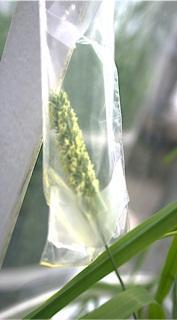AMHERST, Mass. – Results of a new study by scientists at the University of Massachusetts Amherst strongly suggest that there will be notable increases in grass pollen production and allergen exposure up to 202 percent in the next 100 years, leading to a significant, worldwide impact on human health due to predicted rises in carbon dioxide (CO2) and ozone (O3) due to climate change.
While CO2 stimulates reproduction and growth in plants, ozone has a negative impact on plant growth, the authors point out. In this study in Timothy grass, researchers led by environmental health scientist Christine Rogers of the UMass Amherst School of Public Health and Health Sciences (SPHHS) determined the interactive effects of CO2 and ozone at projected higher levels on pollen production and concentrations of a Timothy grass pollen protein that is a major human allergen. Findings are reported in the current issue of PLOS ONE.
Rogers and plant science colleagues at UMass Amherst, with postdoctoral researcher and first author Jennifer Albertine, write, "The implications of increasing CO2 for human health are clear. Stimulation of grass pollen production by elevated CO2 will increase airborne concentrations and increase exposure and suffering in grass pollen-allergic individuals."

A study provides the first evidence that pollen production is significantly stimulated by elevated carbon dioxide in a grass species as a result of climate change, which may have significant impact on human health.
(Photo Credit: UMass Amherst)
Rogers notes that, "This is the first evidence that pollen production is significantly stimulated by elevated carbon dioxide in a grass species and has worldwide implications due to the ubiquitous presence of grasses in all biomes and high prevalence of grass pollen allergy. These results are similar to our other studies performed in other highly allergenic taxa such as ragweed but with more extreme outcomes and wider impacts."
For these experiments, the researchers exposed grass plants in specially designed continuously stirred tank reactor chambers that allow researchers to expose plants to different atmospheric gas concentrations. They established four experimental atmospheric treatments:
- control, current atmosphere (30 ppb O3 and 400 ppm CO2)
- elevated O3, current CO2 (80 ppb O3, 400 ppm CO2)
- current O3, elevated CO2 (30 ppb O3, 800 ppm CO2)
- elevated O3, elevated CO2 (80 ppb O3, 800ppm CO2)
At the appropriate plant development stage, Albertine and colleagues bagged flowers, captured and measured pollen amounts and extracted the allergen protein Phl p 5 from pollen samples for measurement by enzyme-linked immunosorbent assay (ELISA).
They found that elevated CO2 of 800 ppm, increased pollen production per flower by 53 percent while the different ozone levels had no effect on the amount of pollen produced. There was also a trend of increased number of plants flowering in response to elevated CO2 further increasing pollen production up to 200 percent. While elevated ozone did decrease the Phl p 5 allergen content in pollen, "the strong CO2-stimulation of pollen production suggests increased exposure to Timothy grass allergen overall," even if O3 projections are realized, the authors note.
They add that the health implications of increased ozone are "more complex" because higher levels of this greenhouse gas irritate mucous membranes and worsen the allergic airway response. Projected ozone increases "would likely elicit negative respiratory health effects independent of any health effects as a result of increased pollen by elevated CO2."